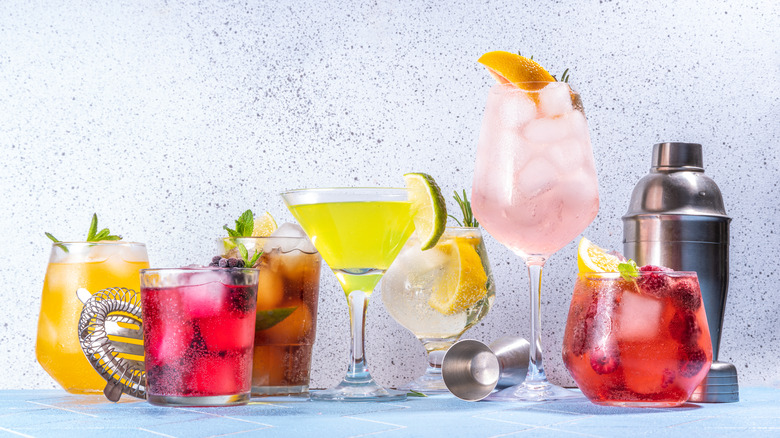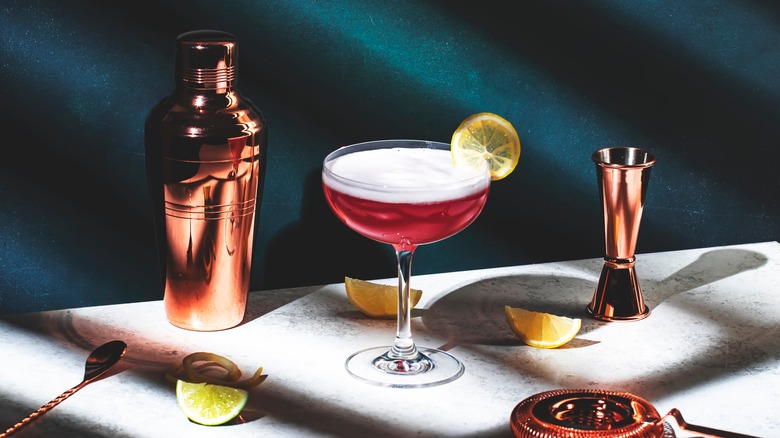What Exactly Is A Mocktail Drink (And Where Did The Trend Originate)?
Starting around 2018, the beverage industry saw a surge in the popularity of mocktails. Nonalcoholic breweries were seeing a steep increase in demand for products, and Gen Z was being lauded as leading the way in a new culture that was more focused on nonalcoholic drinks. Dry January became widely observed, and stores began setting valuable shelf space aside for non-alcoholic spirits, de-alcoholized wine, and of course, mocktails.
That all might make it seem like mocktails are the latest and greatest new trend, but they've been around for a really long time. The term "mocktail" was coined in 1916, but the idea of nonalcoholic cocktails goes back to at least the middle of the 19th century. Before they were called mocktails, they were called temperance drinks — and bars prided themselves on their selections of alcohol-free cocktails, while bartenders' how-to books included entire sections on these booze-free drinks.
A mocktail is exactly what it sounds like... and more. It's officially defined as an alcohol-free cocktail, but it's also a drink that's made with carefully measured ingredients that are often curated to taste like popular alcoholic drinks and they can be incredibly complicated to make. There's a unique science to crafting today's store-bought mocktails, and today's trending popularity of these alcohol-free drinks has actually been generations in the making.
Mocktails were a big deal from the mid-19th century through Prohibition
Mocktails go back a long way, and in 1862, Jerry Thomas's "The Bar-Tender's Guide" included recipes for non-alcoholic creations alongside instructions on how to drink absinthe, and many ways to make a whiskey punch. A chapter called "Temperance Drinks" shares recipes for plenty of lemonade drinks, and common drink ingredients include cream of tartar, eggs, ginger ale, and soda water.
By the time Prohibition rolled around, people had been enjoying nonalcoholic drinks for some time, and the outlawing of the sale of liquor meant that the market was ready for more. One of the ways it was promoted was as a healthy alternative to alcoholic drinks, something that sounds familiar in today's world. There were very real health concerns prevalent at the time that aren't today: The alcohol that was available during Prohibition was often tainted with bad ingredients or poisoned, and was responsible for killing thousands.
Unsurprisingly, that meant mocktails got a big boost in the 1920s. The Women's Christian Temperance Union devoted an entire department to the development of mocktail recipes. It was called the Non-Alcoholic Fruit Products Department, and the idea was that they were going to give Americans ideas for drinks that they could be proud to serve at even the most elegant of parties. The results were the so-called "prohibition punches," and they were given names like Raspberry Shrub and Honey Iced Chocolate. Prohibition was repealed, but the drinks remained pretty popular.
Straightforward temperance drinks have given way to the science of mocktails
Today, mocktails include complex drinks like the grapefruit basil kombucha mocktail with butterfly pea flower shaved ice. Early nonalcoholic drinks were straightforward, like the Arnold Palmer (lemonade and iced tea), the Roy Rogers (cola, grenadine, and a cherry), and the iconic Shirley Temple. That's similar to a Roy Rogers, but with lemon lime soda instead of cola. Jerry Thomas's 1862 book includes directons for making lemonade, and calls for the juice and rinds of lemons, water, and sugar — along with the note: "Fine for parties."
By Prohibition, drinks had gotten more elaborate. WCTU activist Roxana Doran's book, "Prohibition Punches," promoted favorite recipes of the Washington D.C. elite, with recipes for drinks like a lemonade and orange juice cocktail with shredded pineapple, tea, sugar, and a mineral water called Apollinaris. Mocktails weren't just meant to replace alcohol, they were meant to be a classy, elegant option.
Today, the process of making mocktails looks much different. Companies developing and selling bottled and canned mocktails are relying on technologies developed using a combination of chemistry and biology to mimic alcoholic drinks without ethanol. And it's not easy: Ethanol isn't just an alcohol, it's a compound that allows other flavors and ingredients to bind together — which you can't do with water. Mocktails have gone from mixing up lemonade to cutting-edge science, creating a market that surpassed $11 billion in 2022.


